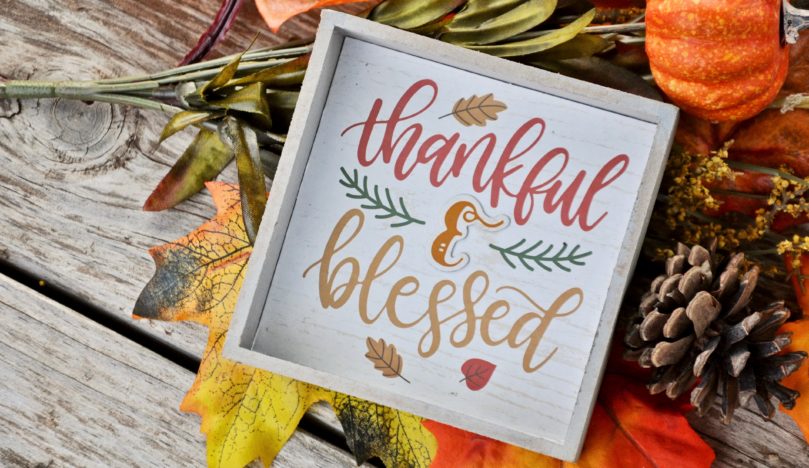“give thanks in all circumstances; for this is God’s will for you in Christ Jesus.”
1 Thessalonians 5:18 – NIV
Thanksgiving is almost here, yet if we walk into a store there is almost no indication of this. Instead, we are met with the consumerism of Christmas. It makes sense. Yes, we buy and prep for a feast at Thanksgiving, but we spend much more as a culture on Christmas and the stores make much more revenue on us at Christmas.
I love Christmas. It’s my favorite holiday, but I also love how Thanksgiving prepares the way for Christmas. What better way to prepare for the celebration of the birth of Jesus than to focus upon gratitude? And this year I really want to actively practice gratitude. To pause at Thanksgiving and not skip ahead to Christmas.
In 1 Thessalonians 5:18 Paul tells us: “give thanks in all circumstances.” Sure Paul, that sounds easy, but not all our circumstances are ones we want to be thankful for. That’s ok. Even in our darkest seasons, if we actively look for things to be grateful for, we will find them. We see what we look for.
Why would we want to actively practice gratitude? Aside from the fact that “every good and perfect gift is from above, coming down from the Father of the heavenly lights (James 1:17a),” gratitude is good for us. When we acknowledge God as the giver of our gifts, we connect deeper with God. We fill our faith bucket as we reflect upon his goodness and faithfulness to us.
There are many examples of practicing gratitude in the Bible. In the Old Testament after Israel crossed over the Jordan River on dry land, the Lord instructed Joshua to have one man from each tribe of Israel take one stone from the dry riverbed. These stones where then erected into a monument and the Israelites were told:
In the future, when your children ask you, ‘What do these stones mean?’ tell them that the flow of the Jordan was cut off before the ark of the covenant of the Lord. When it crossed the Jordan, the waters of the Jordan were cut off. ”
Joshua 4:6b-7a – NIV
Similarly, the prophet Samuel erected a stone and named it “Ebenezer” to remind the people of God’s protection and a great military victory over the Philistine army (1 Samuel 7:12).
There is also scientific evidence of the benefits of gratitude. Psychologists Dr. Robert A. Emmons of the University of California, Davis, Dr. Michael E. McCullough of the University of Miami & Dr. Martin E. Seligman of the University of Pennsylvania have all researched gratitude. Their findings? Writing about gratitude results in individuals feeling more optimistic and correlated to these individuals exercising more and going to the doctor less. Sending thank you notes to someone who had never been properly thanked resulted in a feeling of greater overall happiness in life that lasted a month for participants.
I recently listened to Oprah’s Super Soul podcast with Dr. Brenѐ Brown, a professor, New York Times best-selling author and nationally acclaimed speaker. Dr. Brown has studied shame and vulnerability, and this has led her to create a list of qualifications for what she calls – wholehearted living. In her research she said:
“I have never interviewed a single person who talks about the capacity to really experience and soften into joy who does not actively practice gratitude.”
Practicing gratitude is a powerful tool we should tap into. Not only is it tied to our faith, happiness, and health, but also our capacity for joy. Who wouldn’t want to experience more of all of these in life?
So, let’s get practical, how can we actively practice gratitude? Here is a list of suggestions:
- Keep a Gratitude Journal or list. It doesn’t have to be fancy. After reading Ann Voskamp’s book One Thousand Gifts, I set out to catalog 1,000 gifts in my life. I just have a running list in the notes on my phone. Simple, easy and I always have my phone on hand.
- Pray with a heart of gratitude. Look for things to be thankful for and then thank God for them in prayer.
- Write a thank you note. We all have people who have done kind things or been generous toward us. Let’s pause and write them a note thanking them.
- Create a visual reminder of gratitude, an Ebenezer, something that when you see it you will be reminded of your blessings. This could be a craft and even young children could participate in this. Create a gratitude jar. Have pieces of paper where we can write what we are grateful for. We could even make those pieces of paper into cute little shapes and when we are done turn them into a decorative wreath or a piece of art. Then on Thanksgiving, take the time to pull each paper out and read them aloud.
As we prepare our hearts for Thanksgiving let’s pause together and actively practice gratitude together. Wishing you a very Happy Thanksgiving!
